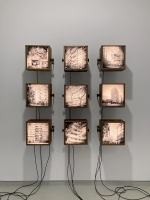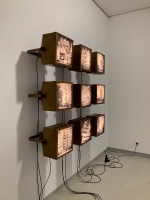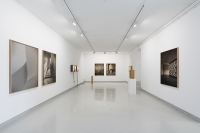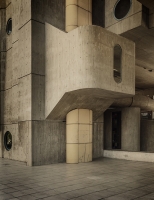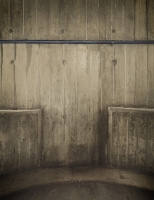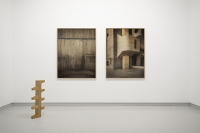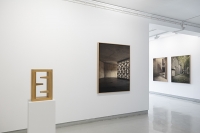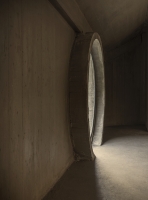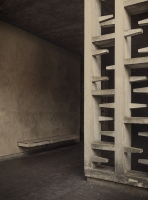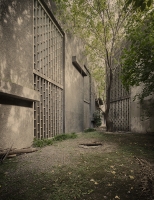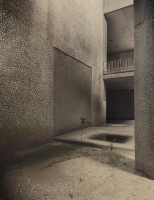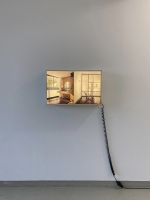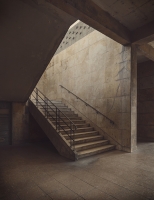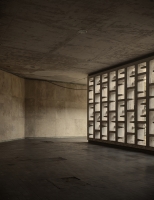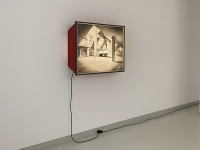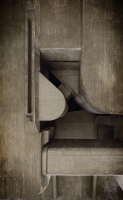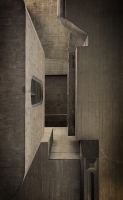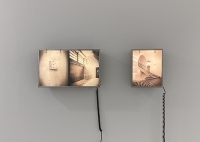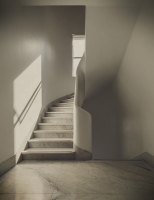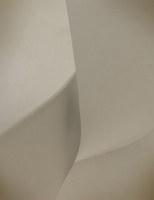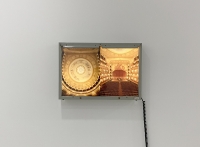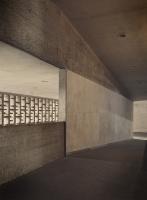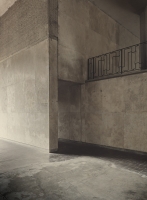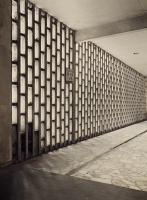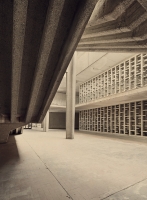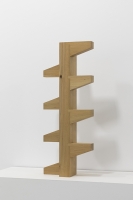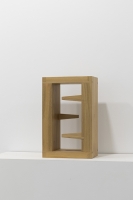Umbral
Umbral results from research into works by the first Argentinian female architects working in Buenos Aires.
The Sixth Pantheon of Chacarita, designed in 1958 by Ítala Fulvia Villa, one of the
first women to graduate in architecture from the University of Buenos Aires, imposes itself as the dominant structure of this series. Brilliant work of modernity, both rationalist and brutalist,
classified in 2023 as a monument of public interest, it was, for years, voted to oblivion. With its surfaces, wedged between the earth and the sky, they have become impregnated with the beautiful and inimitable stains of time and use.
Perhaps as an effect of the patriarchal perspective of history, the authorship of the Sixth Pantheon was often confused with being one of the project's young collaborators, the
architect Clorindo Testa. This finding was a trigger for the emergence of Umbral.
Through so many kilometers on foot through the hustle and bustle of the streets of huge Buenos Aires, among many admirable buildings of the city's modern architecture, this series brings together
several works captured from a female perspective and revealed with ambitious
Feminism.
Umbral discovers buildings such as the house of Victoria Ocampo, one of the main intellectual figures of her time, a great fighter for the causes of women, freedom and antifascism, sister of Silvina Ocampo. Like the Teatro Colón, where you can see camouflaged boxes used by widows who could not be seen watching the shows. Like the Ministry of Public Works building, where Evita Perón gave the famous Renunciamiento speech. Or as the set of nine distinct more or less anonymous residential buildings, built between 1939 and 1970, with architectural projects designed by women.
Inês d’Orey continues her investigation into the city’s heritage identity contemporary culture, its places and contexts. With Umbral, she discovers Buenos Aires as a device that allows you to read a feminine narrative of the city.
In Umbral, 3 sculptures are presented, inspired by existing modules in the Sixth Pantheon of Chacarita, in Buenos Aires. They function as a tribute to Ítala Fulvia Villa designs. Originally made of concrete and integrated into a repetitive pattern in banisters or panels, they can be identified in some of the photographs from the same series.
They were exemplarily executed by @diogo.amaro in acacia wood with Japanese fittings, without a single screw.
It is alsopresented a panel made with 9 photographs with different residential buildings built between 1939 and 1970 by the first Argentinian female architects. Ítala Fulvia Villa, Violeta Lorraine Pouchkine, Angelina Camicia, Alicia Cazzaniga, Carmen Córdova, Mabel Lapacó, Lydia Esther Prat, Débora Di Veroli, Beatriz Escudero e Maria Teresa Egozcue.
Umbral resulta de uma pesquisa em torno de obras das primeiras arquitectas, mulheres
e argentinas, a trabalhar em Buenos Aires.
O Sexto Panteão de Chacarita, desenhado em 1958 por Ítala Fulvia Villa, uma das
primeiras mulheres a formar-se em arquitectura pela Universidade de Buenos Aires, impõe-se como estrutura dominante desta série. Brilhante obra da modernidade, com tanto de racionalista como de brutalista, classificada em 2023 como monumento de interesse público, foi, durante anos, votada
ao esquecimento, com as suas superfícies, entaladas entre a terra e o céu, a
impregnaram-se das belas e inimitáveis manchas do tempo e do uso.
Talvez como efeito da perspectiva patriarcal da história, a autoria do Sexto Panteão foi
muitas vezes confundida com sendo de um dos jovens colaboradores do projecto, o
arquitecto Clorindo Testa. Esta constatação foi um rastilho para a eclosão de Umbral.
Através de tantos quilómetros a pé pela azáfama das ruas da enorme Buenos Aires, por
entre muitos edifícios admiráveis da arquitectura moderna da cidade, esta série reúne
diversas obras captadas sob uma perspectiva feminina e reveladas com ambições
feministas.
Umbral descobre edifícios como a casa de Victoria Ocampo, uma das principais figuras
intelectuais do seu tempo, grande lutadora pelas causas da mulher, da liberdade e do
antifascismo, irmã de Silvina Ocampo. Como o Teatro Colón, onde se podem ver
camarotes camuflados utilizados pelas viúvas que não podiam ser vistas a assistir os
espectáculos. Como o edifício do Ministério das Obras Públicas, onde Evita Perón
proferiu o famoso discurso do Renunciamiento. Ou como o conjunto de nove distintos
edifícios de habitação mais ou menos anónimos, erguidos entre 1939 e 1970, com
projectos de arquitectura concebidos por mulheres.
Inês d’Orey prossegue com a investigação sobre a identidade patrimonial da cidade
contemporânea, os seus lugares e os seus contextos. Com Umbral, desvenda Buenos Aires como um dispositivo que permite ler uma narrativa feminina de cidade.
Em Umbral, são apresentadas esculturas desenhadas a partir de módulos existentes no Sexto Panteão de Chacarita, em Buenos Aires, um tributo a Ítala Fulvia Villa. Feitos originalmente de betão e integrados num padrão repetitivo em guardas ou painéis, podem identificar-se nas fotografias da série. Foram exemplarmente executadas por Diogo Amaro em madeira de acácia com encaixes japoneses, sem um único parafuso.
Em Umbral, é apresentado um painel constituído por 9 fotografias com diferentes edifícios de habitação construídos entre 1939 e 1970 pelas primeiras arquitectas argentinas.
Ítala Fulvia Villa, Violeta Lorraine Pouchkine, Angelina Camicia, Alicia Cazzaniga, Carmen Córdova, Mabel Lapacó, Lydia Esther Prat, Débora Di Veroli, Beatriz Escudero e Maria Teresa Egozcue.
Umbral results from research into works by the first Argentinian female architects working in Buenos Aires.
The Sixth Pantheon of Chacarita, designed in 1958 by Ítala Fulvia Villa, one of the
first women to graduate in architecture from the University of Buenos Aires, imposes itself as the dominant structure of this series. Brilliant work of modernity, both rationalist and brutalist,
classified in 2023 as a monument of public interest, it was, for years, voted to oblivion. With its surfaces, wedged between the earth and the sky, they have become impregnated with the beautiful and inimitable stains of time and use.
Perhaps as an effect of the patriarchal perspective of history, the authorship of the Sixth Pantheon was often confused with being one of the project's young collaborators, the
architect Clorindo Testa. This finding was a trigger for the emergence of Umbral.
Through so many kilometers on foot through the hustle and bustle of the streets of huge Buenos Aires, among many admirable buildings of the city's modern architecture, this series brings together
several works captured from a female perspective and revealed with ambitious
Feminism.
Umbral discovers buildings such as the house of Victoria Ocampo, one of the main intellectual figures of her time, a great fighter for the causes of women, freedom and antifascism, sister of Silvina Ocampo. Like the Teatro Colón, where you can see camouflaged boxes used by widows who could not be seen watching the shows. Like the Ministry of Public Works building, where Evita Perón gave the famous Renunciamiento speech. Or as the set of nine distinct more or less anonymous residential buildings, built between 1939 and 1970, with architectural projects designed by women.
Inês d’Orey continues her investigation into the city’s heritage identity contemporary culture, its places and contexts. With Umbral, she discovers Buenos Aires as a device that allows you to read a feminine narrative of the city.
In Umbral, 3 sculptures are presented, inspired by existing modules in the Sixth Pantheon of Chacarita, in Buenos Aires. They function as a tribute to Ítala Fulvia Villa designs. Originally made of concrete and integrated into a repetitive pattern in banisters or panels, they can be identified in some of the photographs from the same series.
They were exemplarily executed by @diogo.amaro in acacia wood with Japanese fittings, without a single screw.
It is alsopresented a panel made with 9 photographs with different residential buildings built between 1939 and 1970 by the first Argentinian female architects. Ítala Fulvia Villa, Violeta Lorraine Pouchkine, Angelina Camicia, Alicia Cazzaniga, Carmen Córdova, Mabel Lapacó, Lydia Esther Prat, Débora Di Veroli, Beatriz Escudero e Maria Teresa Egozcue.
Umbral resulta de uma pesquisa em torno de obras das primeiras arquitectas, mulheres
e argentinas, a trabalhar em Buenos Aires.
Perhaps as an effect of the patriarchal perspective of history, the authorship of the Sixth Pantheon was often confused with being one of the project's young collaborators, the
architect Clorindo Testa. This finding was a trigger for the emergence of Umbral.
Through so many kilometers on foot through the hustle and bustle of the streets of huge Buenos Aires, among many admirable buildings of the city's modern architecture, this series brings together
several works captured from a female perspective and revealed with ambitious
Feminism.
Umbral discovers buildings such as the house of Victoria Ocampo, one of the main intellectual figures of her time, a great fighter for the causes of women, freedom and antifascism, sister of Silvina Ocampo. Like the Teatro Colón, where you can see camouflaged boxes used by widows who could not be seen watching the shows. Like the Ministry of Public Works building, where Evita Perón gave the famous Renunciamiento speech. Or as the set of nine distinct more or less anonymous residential buildings, built between 1939 and 1970, with architectural projects designed by women.
Inês d’Orey continues her investigation into the city’s heritage identity contemporary culture, its places and contexts. With Umbral, she discovers Buenos Aires as a device that allows you to read a feminine narrative of the city.
In Umbral, 3 sculptures are presented, inspired by existing modules in the Sixth Pantheon of Chacarita, in Buenos Aires. They function as a tribute to Ítala Fulvia Villa designs. Originally made of concrete and integrated into a repetitive pattern in banisters or panels, they can be identified in some of the photographs from the same series.
They were exemplarily executed by @diogo.amaro in acacia wood with Japanese fittings, without a single screw.
It is alsopresented a panel made with 9 photographs with different residential buildings built between 1939 and 1970 by the first Argentinian female architects. Ítala Fulvia Villa, Violeta Lorraine Pouchkine, Angelina Camicia, Alicia Cazzaniga, Carmen Córdova, Mabel Lapacó, Lydia Esther Prat, Débora Di Veroli, Beatriz Escudero e Maria Teresa Egozcue.
Umbral resulta de uma pesquisa em torno de obras das primeiras arquitectas, mulheres
e argentinas, a trabalhar em Buenos Aires.
Inês d’Orey continues her investigation into the city’s heritage identity contemporary culture, its places and contexts. With Umbral, she discovers Buenos Aires as a device that allows you to read a feminine narrative of the city.
In Umbral, 3 sculptures are presented, inspired by existing modules in the Sixth Pantheon of Chacarita, in Buenos Aires. They function as a tribute to Ítala Fulvia Villa designs. Originally made of concrete and integrated into a repetitive pattern in banisters or panels, they can be identified in some of the photographs from the same series.
They were exemplarily executed by @diogo.amaro in acacia wood with Japanese fittings, without a single screw.
It is alsopresented a panel made with 9 photographs with different residential buildings built between 1939 and 1970 by the first Argentinian female architects. Ítala Fulvia Villa, Violeta Lorraine Pouchkine, Angelina Camicia, Alicia Cazzaniga, Carmen Córdova, Mabel Lapacó, Lydia Esther Prat, Débora Di Veroli, Beatriz Escudero e Maria Teresa Egozcue.
Umbral resulta de uma pesquisa em torno de obras das primeiras arquitectas, mulheres
e argentinas, a trabalhar em Buenos Aires.
It is alsopresented a panel made with 9 photographs with different residential buildings built between 1939 and 1970 by the first Argentinian female architects. Ítala Fulvia Villa, Violeta Lorraine Pouchkine, Angelina Camicia, Alicia Cazzaniga, Carmen Córdova, Mabel Lapacó, Lydia Esther Prat, Débora Di Veroli, Beatriz Escudero e Maria Teresa Egozcue.
Umbral resulta de uma pesquisa em torno de obras das primeiras arquitectas, mulheres
e argentinas, a trabalhar em Buenos Aires.
e argentinas, a trabalhar em Buenos Aires.
primeiras mulheres a formar-se em arquitectura pela Universidade de Buenos Aires, impõe-se como estrutura dominante desta série. Brilhante obra da modernidade, com tanto de racionalista como de brutalista, classificada em 2023 como monumento de interesse público, foi, durante anos, votada
ao esquecimento, com as suas superfícies, entaladas entre a terra e o céu, a
impregnaram-se das belas e inimitáveis manchas do tempo e do uso.
muitas vezes confundida com sendo de um dos jovens colaboradores do projecto, o
arquitecto Clorindo Testa. Esta constatação foi um rastilho para a eclosão de Umbral.
Através de tantos quilómetros a pé pela azáfama das ruas da enorme Buenos Aires, por
entre muitos edifícios admiráveis da arquitectura moderna da cidade, esta série reúne
diversas obras captadas sob uma perspectiva feminina e reveladas com ambições
feministas.
intelectuais do seu tempo, grande lutadora pelas causas da mulher, da liberdade e do
antifascismo, irmã de Silvina Ocampo. Como o Teatro Colón, onde se podem ver
camarotes camuflados utilizados pelas viúvas que não podiam ser vistas a assistir os
espectáculos. Como o edifício do Ministério das Obras Públicas, onde Evita Perón
proferiu o famoso discurso do Renunciamiento. Ou como o conjunto de nove distintos
edifícios de habitação mais ou menos anónimos, erguidos entre 1939 e 1970, com
projectos de arquitectura concebidos por mulheres.
contemporânea, os seus lugares e os seus contextos. Com Umbral, desvenda Buenos Aires como um dispositivo que permite ler uma narrativa feminina de cidade.

